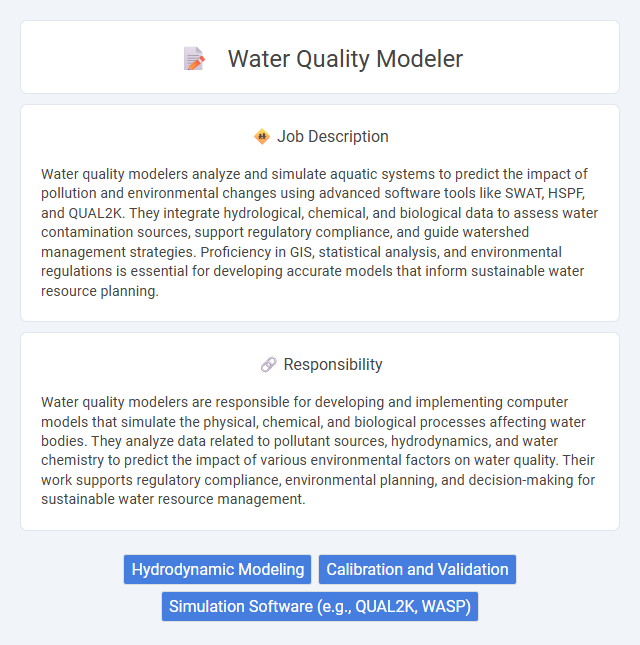
Water quality modelers analyze and simulate aquatic systems to predict the impact of pollution and environmental changes using advanced software tools like SWAT, HSPF, and QUAL2K. They integrate hydrological, chemical, and biological data to assess water contamination sources, support regulatory compliance, and guide watershed management strategies. Proficiency in GIS, statistical analysis, and environmental regulations is essential for developing accurate models that inform sustainable water resource planning.
Individuals with strong analytical skills and a background in environmental science or engineering are likely to be well-suited for a water quality modeler job. Those who are comfortable working with complex data sets and possess an interest in aquatic ecosystems might find this role fulfilling. Candidates who prefer solitary, detail-oriented work environments could probably thrive, while those seeking highly social or fast-paced roles may be less compatible.
Qualification
A water quality modeler requires a strong foundation in environmental science, hydrology, or civil engineering, often supported by a bachelor's or master's degree in these fields. Proficiency in simulation software such as SWAT, QUAL2K, or HSPF is essential for accurately assessing pollution sources and water body conditions. Expertise in data analysis, GIS applications, and regulatory compliance frameworks like the Clean Water Act enhances the ability to develop predictive models for water resource management.
Responsibility
Water quality modelers are responsible for developing and implementing computer models that simulate the physical, chemical, and biological processes affecting water bodies. They analyze data related to pollutant sources, hydrodynamics, and water chemistry to predict the impact of various environmental factors on water quality. Their work supports regulatory compliance, environmental planning, and decision-making for sustainable water resource management.
Benefit
Water quality modeler roles likely offer the benefit of influencing environmental management and policy decisions through accurate simulation of water systems. This position probably provides opportunities for collaboration with interdisciplinary teams to develop sustainable water resource strategies. Employees in this field may experience professional growth by applying advanced analytical tools to predict and mitigate water pollution impacts.
Challenge
Water quality modeler roles likely involve complex challenges related to accurately simulating the interactions between pollutants and aquatic ecosystems under varying environmental conditions. The probability of encountering difficulties in calibrating models due to data limitations and variability in water sources may be high. Addressing these challenges requires strong analytical skills and expertise in environmental science and computational techniques.
Career Advancement
Water quality modelers utilize advanced computational tools and environmental data to simulate pollutant dispersion and water system behavior, providing crucial insights for regulatory compliance and environmental protection. Career advancement typically involves gaining expertise in Geographical Information Systems (GIS), hydrological modeling software like SWAT or QUAL2K, and achieving certifications such as Professional Engineer (PE) status or Certified Hydrologist credentials. Progression often leads to senior environmental consultant roles, project management positions, or specialized research and policy development careers within governmental agencies or environmental firms.
Key Terms
Hydrodynamic Modeling
Water quality modelers specializing in hydrodynamic modeling analyze water movement and its interactions with pollutants to predict the distribution of contaminants in aquatic environments. They use advanced software like EPA's WASP, DELFT3D, and MIKE 3 to simulate currents, tides, and water flows, ensuring accurate representation of physical processes. These professionals contribute to environmental impact assessments, regulatory compliance, and the design of water management strategies to improve ecosystem health.
Calibration and Validation
Calibration and validation are critical processes in a water quality modeler's role, ensuring accuracy and reliability of simulation results. The modeler fine-tunes parameters using field data during calibration to minimize errors between observed and predicted values. Validation involves testing the calibrated model against independent datasets to confirm its predictive capability for water quality management and regulatory compliance.
Simulation Software (e.g., QUAL2K, WASP)
Water quality modelers utilize advanced simulation software such as QUAL2K and WASP to analyze and predict the behavior of pollutants in aquatic systems. These tools enable precise modeling of water temperature, dissolved oxygen, nutrient cycles, and contaminant transport, supporting regulatory compliance and environmental decision-making. Expertise in calibration, validation, and scenario analysis using these platforms ensures accurate assessments of water quality under varying conditions.
 kuljobs.com
kuljobs.com